Class 5 Exam > Class 5 Notes > Science Class 5 > Detailed Notes: Diseases & Hygiene
Diseases and Hygiene Class 5 Notes Science
Introduction
- What is the meaning of the word “Disease’?
- The word disease stands for- ‘Dis-ease’ meaning “not at ease” or “uncomfortable.”
- The disease is a condition of the body that does not allow the body to function properly.
- So, whenever a disturbance in the body's normal working occurs, we call it a disease or illness.
There are two types of diseases – non-communicable and communicable diseases.
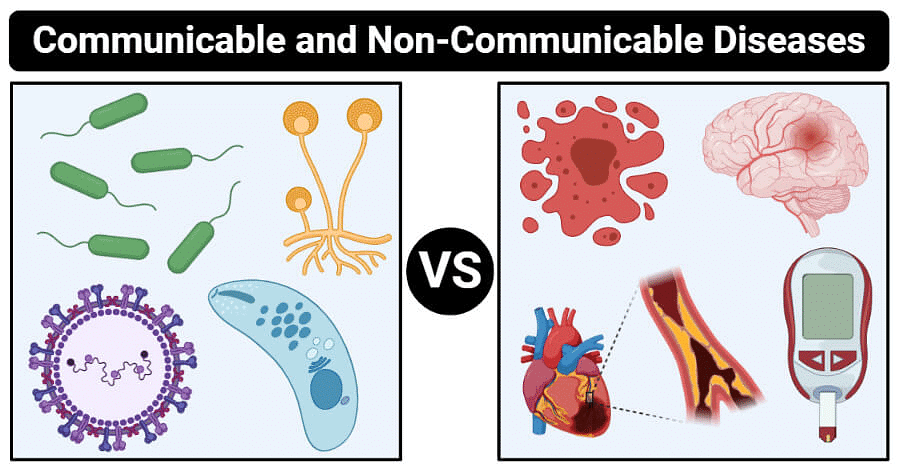
Non-communicable Diseases
- The diseases that do not pass from one person to another are called non-communicable diseases.
- Some non-communicable diseases are caused due to lack of particular vitamins or minerals in the body.
- Such diseases are called deficiency diseases.
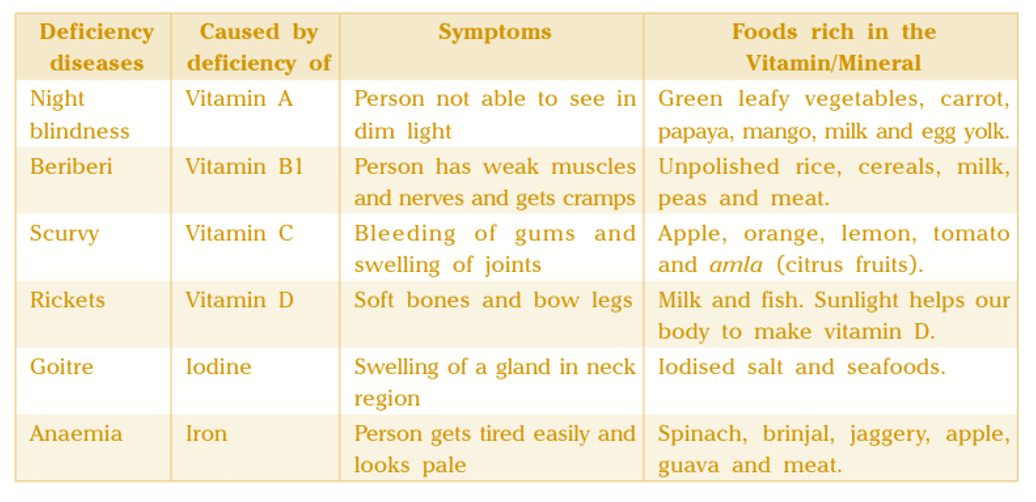
Communicable diseases
- Diseases that can be passed from an infected person to a healthy person in a direct or indirect manner are called communicable diseases.
- These are also called infectious diseases. Communicable diseases are caused by disease-causing germs called pathogens.
- We can also call them infectious agents.
- These disease-causing germs are viruses, bacteria, fungi, protozoa, and worms.
- These can only be seen through a microscope and are called microorganisms or microbes.
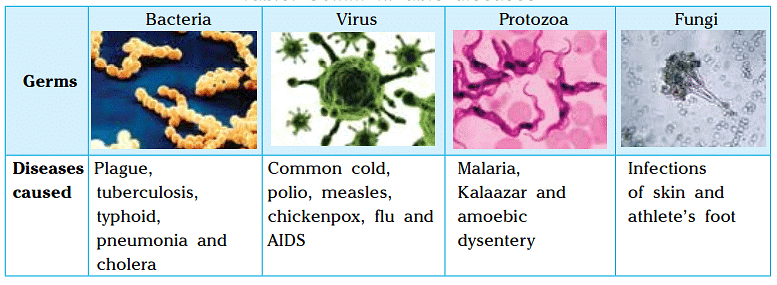
Spread of Communicable Diseases
1. Direct Mode
- Through Direct Contact: Healthy person directly comes in contact with a person suffering from the disease. Diseases can also spread through articles like towels, handkerchiefs and utensils used by the sick person. Diseases like chickenpox, measles, and ringworm spread through direct contact.
 Chickenpox
Chickenpox
- Through Cuts and Wounds in the Skin: Germs can enter the body through cuts and wounds on the skin and cause infection. For example, tetanus. The disease can sometimes spread from the mother to the child during childbirth.
Question for Detailed Notes: Diseases & HygieneTry yourself:What is the meaning of the word "disease"?
View Solution
2. Indirect Mode
- Through Air: When a sick person suffering from the common cold, tuberculosis, diphtheria or influenza coughs or sneezes, germs are released into the air. A healthy person inhaling this air may suffer from the disease as the discharge from the nose and the mouth contains disease-causing germs.
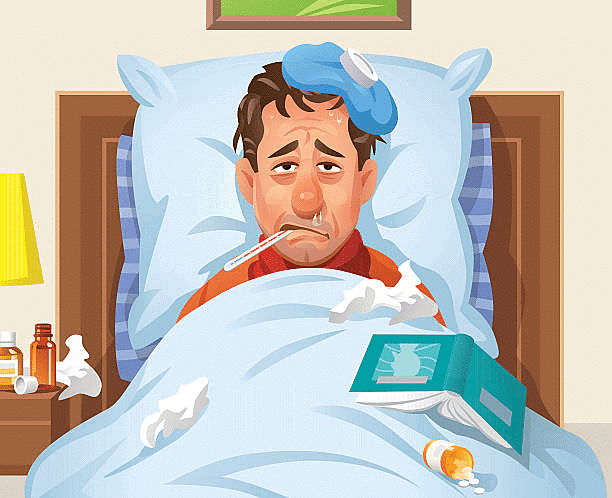
- Through Infected Food and Water: Many germs are transmitted through infected food and water. Organisms like houseflies and cockroaches carry germs on their bodies from dirty places like garbage and sewer.
3. Vectors
- Through Insects: Some of the microorganisms are carried by some insects and animals known as vectors. When an insect-like mosquito bites an infected person, the germs reach the body of the mosquito. This does not harm the mosquito, but when this mosquito bites another healthy person, the germs get transferred into the healthy person's blood and infect him.
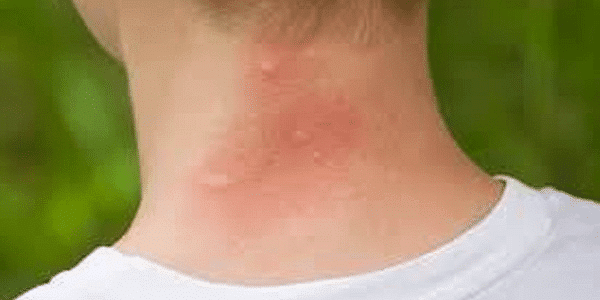 Mosquito Bite
Mosquito Bite
- Through animal bites: Some animals carry germs of certain diseases in their body. Their bite may transfer the germs to the victim and hence cause the disease.
Prevention of Communicable Diseases
Communicable diseases can be prevented by good hygiene and vaccination. Hygiene may be defined as practices that ensure cleanliness and good health.

Following are some steps to maintain good hygiene:
- Wash your hands before and after eating food and after going to the toilet with soap and water.
- Do not allow water to stand in ditches, vessels, coolers, pots, etc., in or around your house. Stagnant water allows the breeding of mosquitoes.
- Use a mosquito net or mosquito repellent at night.
- Wash fruits and vegetables well before cooking or eating them.
- Food must be kept covered to prevent flies from sitting on it.
- Do not allow heaps of garbage to collect near your home. Dustbins should be kept covered.
- Drink clean water. Water can be made clean and germ-free by boiling, filtering, and chlorinating.
Vaccination
Vaccination is another way of preventing communicable diseases. Vaccines are available to prevent diseases like polio, cholera, diphtheria, tetanus, and hepatitis. Vaccination helps our body to acquire immunity against certain diseases.
The document Diseases and Hygiene Class 5 Notes Science is a part of the Class 5 Course Science Class 5.
All you need of Class 5 at this link: Class 5
|
42 videos|230 docs|45 tests
|
FAQs on Diseases and Hygiene Class 5 Notes Science
| 1. What are non-communicable diseases (NCDs) and how do they differ from communicable diseases? |  |
Ans.Non-communicable diseases (NCDs) are diseases that are not transmissible directly from one person to another. They include conditions like heart disease, diabetes, and cancer. In contrast, communicable diseases, such as the flu or COVID-19, can spread from person to person through infection.
| 2. What are common examples of non-communicable diseases? |  |
Ans.Common examples of non-communicable diseases include heart disease, stroke, diabetes, chronic respiratory diseases, and certain types of cancer. These diseases often develop over time and are influenced by lifestyle choices and environmental factors.
| 3. How can non-communicable diseases be prevented? |  |
Ans.NCDs can be prevented by adopting a healthy lifestyle, which includes eating a balanced diet, engaging in regular physical activity, avoiding tobacco use, and limiting alcohol consumption. Regular health check-ups and managing stress are also important for prevention.
| 4. What role does hygiene play in preventing non-communicable diseases? |  |
Ans.Hygiene plays a crucial role in preventing infections that can lead to complications in people with non-communicable diseases. Good hygiene practices, such as hand washing and maintaining cleanliness, help reduce the risk of infections that can worsen these conditions.
| 5. Why is it important to raise awareness about non-communicable diseases? |  |
Ans.Raising awareness about non-communicable diseases is important because it helps people understand the risks and encourages them to make healthier lifestyle choices. Awareness can also promote early detection and effective management of these diseases, ultimately reducing their impact on individuals and communities.
Related Searches






















